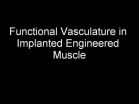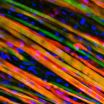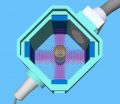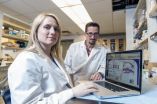(Press-News.org) VIDEO:
After veins grow into the implanted engineered muscle fibers, blood cells can be seen traveling through them, sustaining and nourishing the new tissue.
Click here for more information.
DURHAM, N.C. -- Biomedical engineers have grown living skeletal muscle that looks a lot like the real thing. It contracts powerfully and rapidly, integrates into mice quickly, and for the first time, demonstrates the ability to heal itself both inside the laboratory and inside an animal.
The study conducted at Duke University tested the bioengineered muscle by literally watching it through a window on the back of living mouse. The novel technique allowed for real-time monitoring of the muscle's integration and maturation inside a living, walking animal.
Both the lab-grown muscle and experimental techniques are important steps toward growing viable muscle for studying diseases and treating injuries, said Nenad Bursac, associate professor of biomedical engineering at Duke.
The results appear the week of March 25 in the Proceedings of the National Academy of Sciences Early Edition.
"The muscle we have made represents an important advance for the field," Bursac said. "It's the first time engineered muscle has been created that contracts as strongly as native neonatal skeletal muscle."
Through years of perfecting their techniques, a team led by Bursac and graduate student Mark Juhas discovered that preparing better muscle requires two things -- well-developed contractile muscle fibers and a pool of muscle stem cells, known as satellite cells.
Every muscle has satellite cells on reserve, ready to activate upon injury and begin the regeneration process. The key to the team's success was successfully creating the microenvironments -- called niches -- where these stem cells await their call to duty.
"Simply implanting satellite cells or less-developed muscle doesn't work as well," said Juhas. "The well-developed muscle we made provides niches for satellite cells to live in, and, when needed, to restore the robust musculature and its function."
To put their muscle to the test, the engineers ran it through a gauntlet of trials in the laboratory. By stimulating it with electric pulses, they measured its contractile strength, showing that it was more than 10 times stronger than any previous engineered muscles. They damaged it with a toxin found in snake venom to prove that the satellite cells could activate, multiply and successfully heal the injured muscle fibers.
Then they moved it out of a dish and into a mouse.
With the help of Greg Palmer, an assistant professor of radiation oncology in the Duke University School of Medicine, the team inserted their lab-grown muscle into a small chamber placed on the backs of live mice. The chamber was then covered by a glass panel. Every two days for two weeks, Juhas imaged the implanted muscles through the window to check on their progress.
By genetically modifying the muscle fibers to produce fluorescent flashes during calcium spikes -- which cause muscle to contract -- the researchers could watch the flashes become brighter as the muscle grew stronger.
"We could see and measure in real time how blood vessels grew into the implanted muscle fibers, maturing toward equaling the strength of its native counterpart," said Juhas.
The engineers are now beginning work to see if their biomimetic muscle can be used to repair actual muscle injuries and disease.
"Can it vascularize, innervate and repair the damaged muscle's function?" asked Bursac. "That is what we will be working on for the next several years."
INFORMATION:
This work was supported by a National Science Foundation Graduate Research Fellowship and the National Institute of Arthritis and Musculoskeletal and Skin Diseases (AR055226).
"Biomimetic engineered muscle with capacity for vascular integration and functional maturation in vivo." Juhas, M., Engelmayr, Jr., G.C., Fontanella, A.N., Palmer, G.M., Bursac, N. PNAS Early Edition, March, 2014. DOI: 10.1073/pnas.1402723111
Self-healing engineered muscle grown in the laboratory
Strong, lab-grown muscle is the first to heal itself after animal implantation
2014-03-31
ELSE PRESS RELEASES FROM THIS DATE:
Ancient whodunit may be solved: The microbes did it!
2014-03-31
Evidence left at the crime scene is abundant and global: Fossil remains show that sometime around 252 million years ago, about 90 percent of all species on Earth were suddenly wiped out — by far the largest of this planet's five known mass extinctions. But pinpointing the culprit has been difficult, and controversial.
Now, a team of MIT researchers may have found enough evidence to convict the guilty parties — but you'll need a microscope to see the killers.
The perpetrators, this new work suggests, were not asteroids, volcanoes, or raging coal fires, all of which have ...
Experimental cancer drug reverses schizophrenia in adolescent mice
2014-03-31
Johns Hopkins researchers say that an experimental anticancer compound appears to have reversed behaviors associated with schizophrenia and restored some lost brain cell function in adolescent mice with a rodent version of the devastating mental illness.
The drug is one of a class of compounds known as PAK inhibitors, which have been shown in animal experiments to confer some protection from brain damage due to Fragile X syndrome, an inherited disease in humans marked by mental retardation. There also is some evidence, experts say, suggesting PAK inhibitors could be used ...
Possible explanation for human diseases caused by defective ribosomes
2014-03-31
Ribosomes are essential for life, generating all of the proteins required for cells to grow. Mutations in some of the proteins that make ribosomes cause disorders characterized by bone marrow failure and anemia early in life, followed by elevated cancer risk in middle age. These disorders are generally called "ribosomopathies."
How can ribosomopathies first appear as diseases caused by too few cells, but later turn into diseases caused by too many cells? This paradox has puzzled the scientific community for years. A new study, which uses a genetic approach to examine ...
Oxygen depletion in the Baltic Sea is 10 times worse than a century ago
2014-03-31
This news release is available in German. After several years of discussions, researchers from Aarhus University (Denmark), Lund University (Sweden) and Stockholm University (Sweden) have determined that nutrients from the land are the main cause of widespread areas of oxygen depletion. The results were published on 31 March in the prestigious American journal Proceedings of the National Academy of Sciences.
Nutrients are the villain
The deepest areas of the Baltic Sea have always had a low oxygen content. The inflow of fresh water is actually limited by low thresholds ...
Scientists understand how E. coli clone has become globally distributed
2014-03-31
Scientists have for the first time come closer to understanding how a clone of E. coli, described as the most important of its kind to cause human infections, has spread across the world in a very short time.
E. coli clone ST131 is one of the leading causes of urinary tract and blood stream infections and has crossed the globe at a rapid rate. Worryingly, members of this clone are becoming more resistant to antibiotics. As an indication of scale, more than half of all women will suffer a urinary tract infection at least once in their lives. An international team of scientists, ...
Researchers announce first phononic crystal that can be altered in real time
2014-03-31
Using an acoustic metadevice that can influence the acoustic space and can control any of the ways in which waves travel, engineers have demonstrated, for the first time, that it is possible to dynamically alter the geometry of a three-dimensional colloidal crystal in real time.
The colloidal crystals designed in the study, called metamaterials, are artificially structured materials that extend the properties of existing naturally occurring materials and compounds. The research by academics from the University of Bristol's Department of Mechanical Engineering is published ...
Weaker gut instinct makes teens open to risky behavior
2014-03-31
DURHAM, N.C. -- Making a snap decision usually means following your initial reaction -- going with your gut. That intuitive feeling sprouts from the limbic system, the evolutionarily older and simpler part of the brain that affects emotion, behavior and motivation.
But during adolescence, the limbic system connects and communicates with the rest of the brain differently than it does during adulthood, leaving many adolescents vulnerable to riskier behaviors, according to Duke University researchers.
"We know adolescence is a time of profound social change. It's also ...
New tool helps young adults with sickle cell disease in the transition to adult care
2014-03-31
(Boston) – Child and adolescent hematologists at Boston Medical Center (BMC) have developed a tool to gauge how ready young adults with sickle cell disease are for a transition into adult care. In a new article for the Journal of Pediatric Hematology/Oncology, Amy Sobota, MD, MPH, and her collaborators have shown that a questionnaire geared to the needs of young adults with sickle cell disease can pinpoint areas of need before the patient goes into an adult clinic.
BMC's sickle cell disease transition clinic, which is unique in Boston, was established in 2008 and serves ...
Vibration may help heal chronic wounds
2014-03-31
Wounds may heal more quickly if exposed to low-intensity vibration, report researchers at the University of Illinois at Chicago.
The finding, in mice, may hold promise for the 18 million Americans who have type 2 diabetes, and especially the quarter of them who will eventually suffer from foot ulcers. Their wounds tend to heal slowly and can become chronic or worsen rapidly.
Timothy Koh, UIC professor of kinesiology and nutrition in the UIC College of Applied Health Sciences, was intrigued by studies at Stony Brook University in New York that used very low-intensity ...
Kinder, gentler med school: Students less depressed, learn more
2014-03-31
ST. LOUIS -- Removing pressure from medical school while teaching students skills to manage stress and bounce back from adversity improves their mental health and boosts their academic achievement, Saint Louis University research finds.
Stuart Slavin, M.D., M.Ed., associate dean for curriculum at SLU School of Medicine, is the lead author of the paper, which is published the April edition of Academic Medicine. The problem of depression among medical school students is significant, Slavin said, affecting between 20 and 30 percent of medical students in the U.S., and potentially ...
LAST 30 PRESS RELEASES:
Eye for trouble: Automated counting for chromosome issues under the microscope
The vast majority of US rivers lack any protections from human activities, new research finds
Ultrasound-responsive in situ antigen "nanocatchers" open a new paradigm for personalized tumor immunotherapy
Environmental “superbugs” in our rivers and soils: new one health review warns of growing antimicrobial resistance crisis
Triple threat in greenhouse farming: how heavy metals, microplastics, and antibiotic resistance genes unite to challenge sustainable food production
Earthworms turn manure into a powerful tool against antibiotic resistance
AI turns water into an early warning network for hidden biological pollutants
Hidden hotspots on “green” plastics: biodegradable and conventional plastics shape very different antibiotic resistance risks in river microbiomes
Engineered biochar enzyme system clears toxic phenolic acids and restores pepper seed germination in continuous cropping soils
Retail therapy fail? Online shopping linked to stress, says study
How well-meaning allies can increase stress for marginalized people
Commercially viable biomanufacturing: designer yeast turns sugar into lucrative chemical 3-HP
Control valve discovered in gut’s plumbing system
George Mason University leads phase 2 clinical trial for pill to help maintain weight loss after GLP-1s
Hop to it: research from Shedd Aquarium tracks conch movement to set new conservation guidance
Weight loss drugs and bariatric surgery improve the body’s fat ‘balance:’ study
The Age of Fishes began with mass death
TB harnesses part of immune defense system to cause infection
Important new source of oxidation in the atmosphere found
A tug-of-war explains a decades-old question about how bacteria swim
Strengthened immune defense against cancer
Engineering the development of the pancreas
The Journal of Nuclear Medicine ahead-of-print tip sheet: Jan. 9, 2026
Mount Sinai researchers help create largest immune cell atlas of bone marrow in multiple myeloma patients
Why it is so hard to get started on an unpleasant task: Scientists identify a “motivation brake”
Body composition changes after bariatric surgery or treatment with GLP-1 receptor agonists
Targeted regulation of abortion providers laws and pregnancies conceived through fertility treatment
Press registration is now open for the 2026 ACMG Annual Clinical Genetics Meeting
Understanding sex-based differences and the role of bone morphogenetic protein signaling in Alzheimer’s disease
Breakthrough in thin-film electrolytes pushes solid oxide fuel cells forward
[Press-News.org] Self-healing engineered muscle grown in the laboratoryStrong, lab-grown muscle is the first to heal itself after animal implantation







